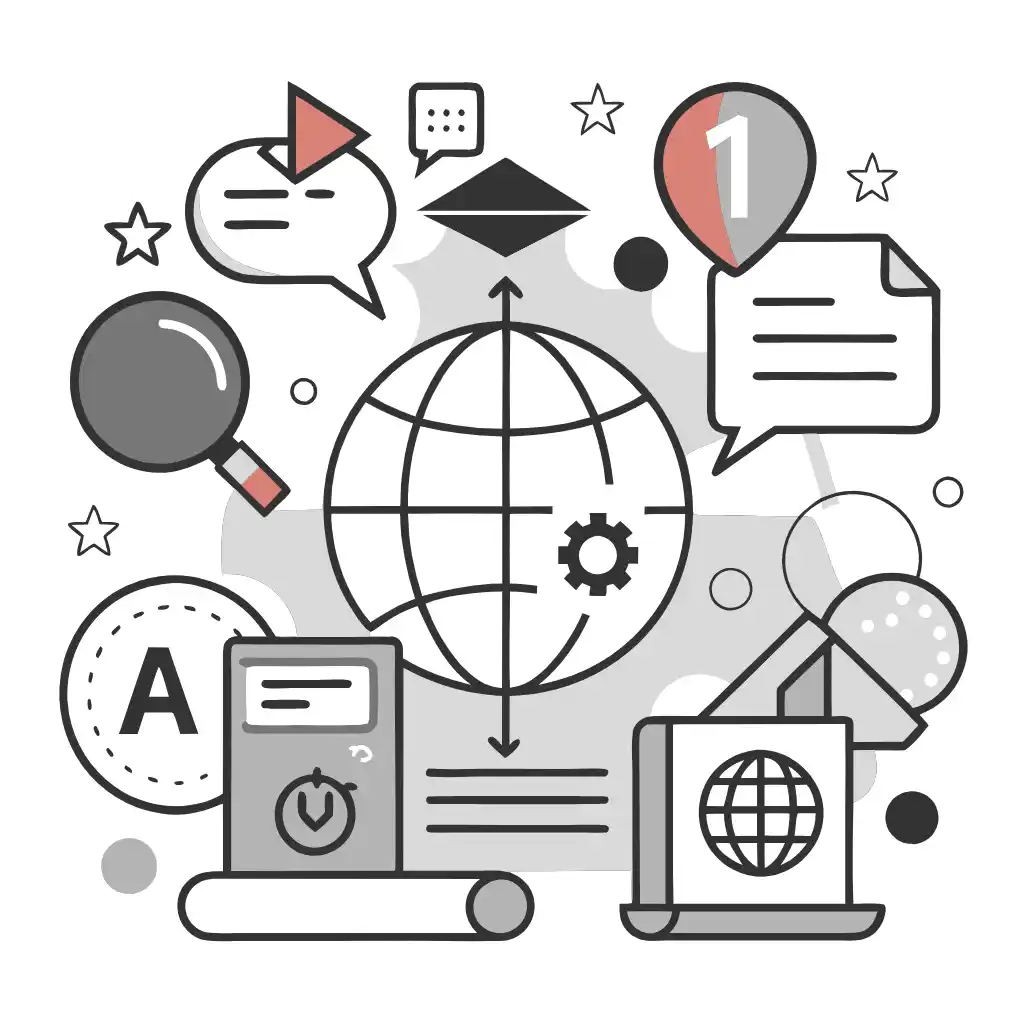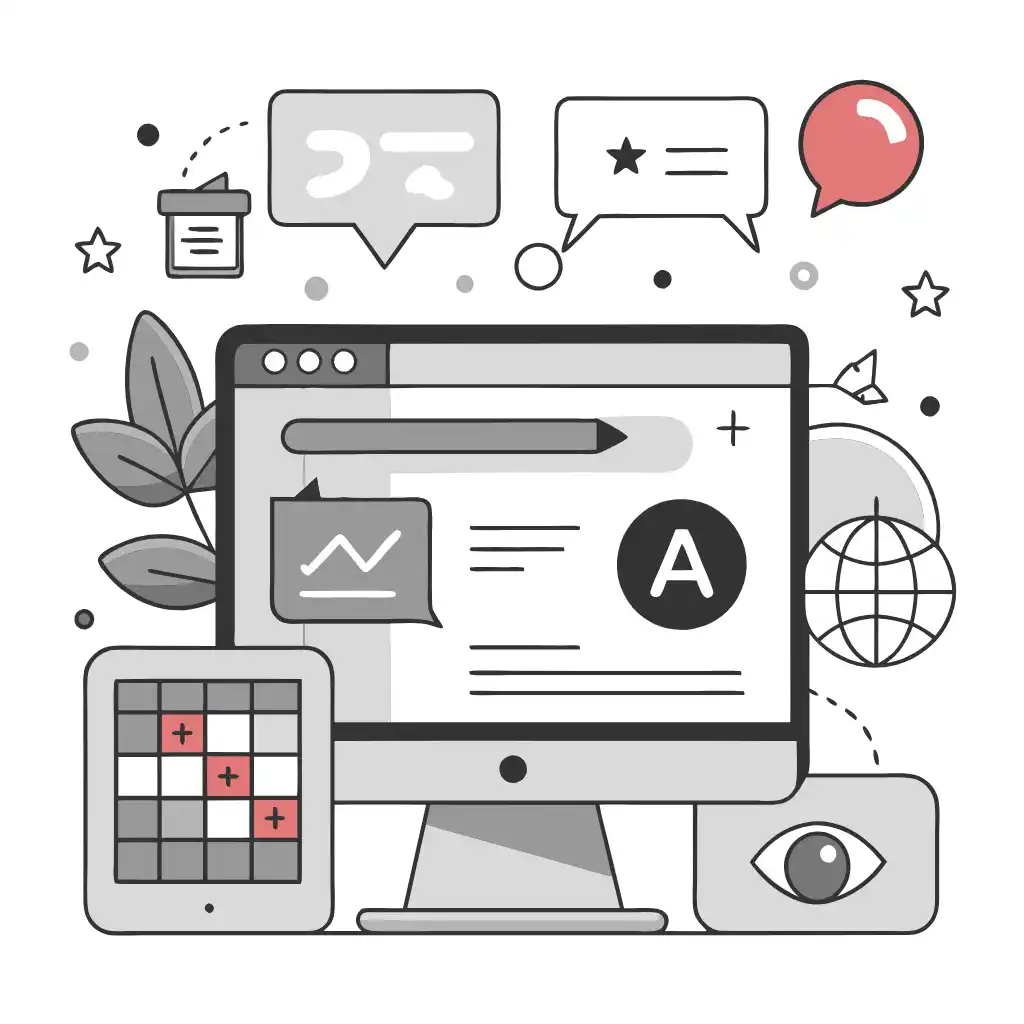स्थानीयकरण के दौरान डिज़ाइन त्रुटियों का समाधान: ConveyThis के साथ अनुवादों का दृश्य संपादन
वैश्विक जुड़ाव में महारत हासिल करना: कुशल बहुभाषी अनुकूलन के माध्यम से उपयोगकर्ता के अनुकूल डिजाइन सुनिश्चित करना
वैश्विक दर्शकों के लिए डिजिटल प्लेटफ़ॉर्म को अनुकूलित करना विविध बाज़ारों पर कब्ज़ा करने की चाहत रखने वाली संस्थाओं के लिए एक महत्वपूर्ण कदम है। यह अनुकूलन प्लेटफ़ॉर्म की पहुंच को बढ़ाता है और उपयोगकर्ताओं के लिए एक अनुरूप अनुभव प्रदान करता है, जो बढ़ती उद्योग प्रतिस्पर्धा के युग में एक प्राथमिकता है।
स्वाभाविक रूप से, भाषा अनुकूलन इस प्रयास का मूल है। हालाँकि, किसी वेबपेज का अनुवाद करना केवल भाषाई परिवर्तन नहीं है - इसमें संभावित लेआउट जटिलताओं से बचना भी शामिल है।
ये समस्याएँ अक्सर भाषा-विशिष्ट विशेषताओं जैसे शब्द की लंबाई और वाक्य निर्माण के कारण उत्पन्न होती हैं, जो ओवरलैपिंग टेक्स्ट या बाधित अनुक्रम जैसी अव्यवस्था का कारण बन सकती हैं, जो निश्चित रूप से विभिन्न पृष्ठभूमि के संभावित उपभोक्ताओं के लिए एक बाधा है।
सौभाग्य से, इन संभावित बाधाओं का एक अभिनव समाधान उपयोगकर्ता के अनुकूल दृश्य संपादन टूल में पाया जा सकता है। सहज ज्ञान युक्त इंटरफेस से सुसज्जित ये उपकरण, वेबसाइट भाषा अनुकूलन से जुड़े अवांछनीय सौंदर्य संबंधी परिणामों को संबोधित करने के लिए डिज़ाइन किए गए हैं, जो विभिन्न भाषाओं में निर्बाध उपयोगकर्ता अनुभव सुनिश्चित करते हैं।
यह लेख इन विज़ुअल संपादकों की क्षमताओं पर प्रकाश डालेगा और इस बात पर प्रकाश डालेगा कि वे एक सहज और आकर्षक बहुभाषी वेबसाइट अनुभव में कैसे योगदान करते हैं।


वैश्विक प्रभाव को सुव्यवस्थित करना: प्रभावी बहुभाषी परिवर्तन के लिए लाइव विज़ुअल संपादकों का उपयोग करना
लाइव विज़ुअल संपादन समाधान आपके डिजिटल प्लेटफ़ॉर्म पर भाषा अनुकूलन का व्यावहारिक, वास्तविक समय अवलोकन प्रदान करते हैं। ये उपकरण रूपांतरित सामग्री का सटीक दृश्य प्रतिनिधित्व प्रदान करते हैं, जिससे संभावित डिज़ाइन परिणामों का सटीक अनुमान लगाया जा सकता है।
भाषा रूपांतरण के परिणामस्वरूप आम तौर पर मूल पाठ की तुलना में रूपांतरित पाठ के आकार में भिन्नता होती है। उदाहरण के लिए, जैसा कि W3.org द्वारा उल्लेख किया गया है, चीनी और अंग्रेजी पाठ अपेक्षाकृत संक्षिप्त है, जिसके परिणामस्वरूप अन्य भाषाओं में परिवर्तित होने पर आकार में पर्याप्त असमानताएं होती हैं।
दरअसल, आईबीएम के "वैश्विक समाधान डिजाइन करने के सिद्धांत" दर्शाते हैं कि 70 अक्षरों से अधिक के पाठ के लिए यूरोपीय भाषाओं में अंग्रेजी अनुवाद के परिणामस्वरूप औसतन 130% का विस्तार होता है। इसका मतलब यह है कि आपके प्लेटफ़ॉर्म का अनुवादित संस्करण 30% अधिक स्थान का उपयोग करेगा, जिससे संभवतः निम्नलिखित जटिलताएँ पैदा होंगी:
टेक्स्ट ओवरलैप संपीड़ित अनुक्रम डिज़ाइन में बाधित समरूपता यह बेहतर ढंग से समझने के लिए कि लाइव विज़ुअल संपादन समाधान इन चुनौतियों को कैसे कम कर सकते हैं, हम एक अनुकरणीय टूल की कार्यक्षमता का पता लगाएंगे। यह अध्ययन प्रदर्शित करेगा कि कैसे ये उपकरण सहज उपयोगकर्ता अनुभव सुनिश्चित करते हुए विभिन्न भाषाओं में डिज़ाइन परिवर्तनों का पूर्वावलोकन कर सकते हैं।
बहुभाषी इंटरफेस का अनुकूलन: प्रभावी भाषा अनुकूलन के लिए वास्तविक समय दृश्य संपादकों का लाभ उठाना
लाइव विज़ुअल एडिटर के साथ जुड़ना आपके केंद्रीय कंसोल से शुरू होता है, आपके "अनुवाद" मॉड्यूल की ओर बढ़ता है, और "लाइव विज़ुअल एडिटर" कार्यक्षमता को सक्रिय करता है।
विज़ुअल एडिटर का चयन करने से आपके प्लेटफ़ॉर्म का वास्तविक समय चित्रण सामने आता है। जबकि डिफ़ॉल्ट पेज होम है, आप उपयोगकर्ता की तरह ब्राउज़ करके अपने प्लेटफ़ॉर्म के विभिन्न अनुभागों को पार कर सकते हैं।
यह चरण आपके मंच के बहुभाषी परिवर्तन पर प्रकाश डालता है। एक भाषा स्विचर आपको भाषाओं के बीच फ़्लिप करने का अधिकार देता है, जिससे लेआउट की खामियों को तुरंत पहचानने और सुधारने में मदद मिलती है। अनुवादों में कोई भी संशोधन तुरंत परिलक्षित होता है।
ध्यान रखें कि संपादन चरण के दौरान, आप अपने अनुवादों के साथ 'लाइव' होने के लिए तैयार नहीं हो सकते हैं। इस प्रकार, आपकी अनुवाद सूची में 'सार्वजनिक दृश्यता' को अक्षम करने से यह सुनिश्चित होता है कि आपका बहुभाषी प्लेटफ़ॉर्म विशेष रूप से आपकी टीम के लिए पहुंच योग्य है। (संकेत: अनुवादों का पूर्वावलोकन करने के लिए अपने URL में ?[निजी टैग]=निजी1 जोड़ें।)
गोपनीयता प्रदान करते समय, भाषाओं के बीच स्थान उपयोग में अंतर देखना दिलचस्प है। उदाहरण के लिए, वेबसाइट शीर्षक में फ़्रेंच और स्पैनिश पाठ वेबसाइट डिज़ाइन में विशिष्ट स्थान रखते हैं।
इससे यह आकलन करने की आवश्यकता का पता चलता है कि नई सम्मिलित भाषाएँ आपके मूल डिज़ाइन में कैसे फिट होती हैं, जिससे आपके प्लेटफ़ॉर्म के प्रभाव का संरक्षण सुनिश्चित होता है।
दिलचस्प बात यह है कि प्राथमिक हेडर टेक्स्ट की लंबाई विभिन्न भाषाओं में काफी भिन्न होती है। लाइव विज़ुअल एडिटर व्यक्ति को इसे समझने और संबंधित समायोजनों पर विचार करने में सक्षम बनाता है।
विज़ुअल संपादक केवल डिज़ाइन के लिए नहीं है; यह टीम के सभी सदस्यों की सहायता करता है। यह वेबसाइट पर उनके वास्तविक संदर्भ में अनुवादों को संपादित करने के लिए एक बहुमुखी उपकरण है, जो इसे भाषा अनुकूलन के लिए एक व्यापक समाधान बनाता है।


बहुभाषी इंटरफेस का अनुकूलन: प्रभावी भाषा एकीकरण के लिए व्यावहारिक समायोजन
लाइव विज़ुअल संपादक का उपयोग करते समय, आप समग्र लेआउट में अनुवादित सामग्री की उपस्थिति से संबंधित मुद्दों की पहचान कर सकते हैं। इन संभावित नुकसानों का पूर्वानुमान लगाया जा सकता है और उचित रूप से समायोजित किया जा सकता है। यहां कुछ संभावित सुधारात्मक उपाय दिए गए हैं:
सामग्री को संक्षिप्त या संशोधित करें: यदि अनुवादित संस्करण लेआउट को परेशान करता है, तो उन हिस्सों को ट्रिम करने या संशोधित करने पर विचार करें जो अच्छी तरह से अनुवाद नहीं करते हैं या अत्यधिक स्थान का उपभोग करते हैं। इसे आपकी टीम द्वारा या पेशेवर भाषाविदों के सहयोग से सीधे आपके डैशबोर्ड से निष्पादित किया जा सकता है।
उदाहरण के लिए, अंग्रेजी 'अबाउट अस' टैब का फ़्रेंच में अनुवाद "ए प्रोपोज़ डी नूस" होता है, जो आपके प्लेटफ़ॉर्म पर आवंटित स्थान में फिट नहीं हो सकता है। एक सीधा समाधान यह हो सकता है कि "ए प्रोपोज़ डी नूस" को "इक्विप" में मैन्युअल रूप से समायोजित किया जाए।
भाषाविदों का नोट अनुभाग अनुवादकों को उन वाक्यांशों के बारे में सूचित करने के लिए एक उपयोगी स्थान है जिन्हें अलग-अलग तरीके से व्यक्त किया जा सकता है। उदाहरण के लिए, नीचे दिया गया CSS स्निपेट जर्मन फ़ॉन्ट आकार को 16px पर समायोजित करता है:
html[lang=de] बॉडी फ़ॉन्ट-आकार: 16px; वेबसाइट का फ़ॉन्ट बदलें: कुछ मामलों में, पाठ का अनुवाद करते समय फ़ॉन्ट को समायोजित करना उचित हो सकता है। कुछ फ़ॉन्ट विशेष भाषाओं के लिए उपयुक्त नहीं हो सकते हैं और डिज़ाइन संबंधी समस्याएं बढ़ सकती हैं। उदाहरण के लिए, आपकी साइट के फ़्रेंच संस्करण के लिए रोबोटो और अरबी संस्करण के लिए एरियल (अरबी के लिए अधिक उपयुक्त) का उपयोग करना सीएसएस नियम के साथ संभव है।
नीचे दिया गया CSS स्निपेट अरबी संस्करण के लिए फ़ॉन्ट को एरियल में समायोजित करता है:
html[lang=ar] बॉडी फ़ॉन्ट-फ़ैमिली: एरियल; वैश्विक वेब डिज़ाइन लागू करें: यदि आपकी वेबसाइट अपने प्रारंभिक चरण में है, और आप कई भाषाओं को शामिल करने की योजना बना रहे हैं, तो संभावित समस्याओं को रोकने के लिए अतिरिक्त स्थान के साथ डिज़ाइन करने पर विचार करें। अधिक डिज़ाइन युक्तियों के लिए, इस व्यापक मार्गदर्शिका को देखें।
लाइव विज़ुअल टूल का उपयोग करना: बहुभाषी प्लेटफार्मों में डिज़ाइन दक्षता को अधिकतम करना
गुडपैच के मामले पर विचार करें, एक जर्मन डिज़ाइन फर्म जिसने अपनी पहले से मौजूद अंग्रेजी वेबसाइट का जर्मन संस्करण पेश करते समय डिज़ाइन विसंगतियों में संशोधन करने के लिए लाइव विज़ुअल एडिटर टूल का सफलतापूर्वक उपयोग किया था। उनका उद्देश्य जर्मन भाषी दर्शकों के एक बड़े हिस्से को आकर्षित करना था, जो अपनी गहरी डिजाइन संवेदनशीलता के लिए जाने जाते हैं।
इस उपक्रम के संभावित डिज़ाइन प्रभाव के बारे में शुरुआती झिझक के बावजूद, लाइव विज़ुअल एडिटर टूल ने तुरंत उनकी चिंताओं को दूर कर दिया। उनकी टीम से अत्यधिक सकारात्मक प्रतिक्रिया के कारण एक सफलता की कहानी सामने आई जिसे एक केस स्टडी के रूप में दर्ज किया गया है।
गुडपैच में यूएक्स और यूआई डिजाइनरों की टीम ने पूर्वावलोकन करने की क्षमता की बहुत सराहना की कि अनुवादित सामग्री उनके वेब पेजों पर कैसे दिखाई देगी। इस त्वरित विज़ुअलाइज़ेशन ने उन्हें डिज़ाइन में अनुकूलन की आवश्यकता वाले तत्वों और स्थानों की पहचान करने में सक्षम बनाया जिन्हें लंबी प्रतिलिपि को समायोजित करने के लिए परिष्कृत किया जा सकता है।
भाषा-निर्भर वेबसाइट अंतरों को विज़ुअलाइज़ करना जबकि गुडपैच ने अन्य अनुवाद समाधानों पर विचार किया था, लाइव विज़ुअल एडिटर टूल के बारे में उन्हें जो आश्वस्त हुआ वह एक डिज़ाइन-केंद्रित संगठन के रूप में उनके दृष्टिकोण के साथ इसका संरेखण था: पुनरावृत्त, दृश्य और अनुभव-आधारित।

अनुवाद, केवल भाषाएँ जानने से कहीं अधिक, एक जटिल प्रक्रिया है।
हमारे सुझावों का पालन करके और ConveyThis का उपयोग करके, आपके अनुवादित पृष्ठ आपके दर्शकों के साथ प्रतिध्वनित होंगे, और उन्हें लक्ष्य भाषा का मूल निवासी महसूस होगा।
हालांकि इसमें मेहनत लगती है, लेकिन इसका परिणाम सुखद होता है। अगर आप किसी वेबसाइट का अनुवाद कर रहे हैं, तो ConveyThis ऑटोमेटेड मशीन ट्रांसलेशन के ज़रिए आपके घंटों की बचत कर सकता है।
ConveyThis को 7 दिनों के लिए निःशुल्क आज़माएँ!